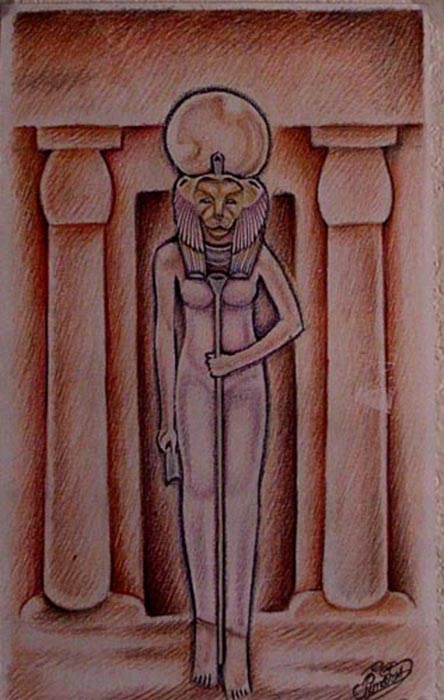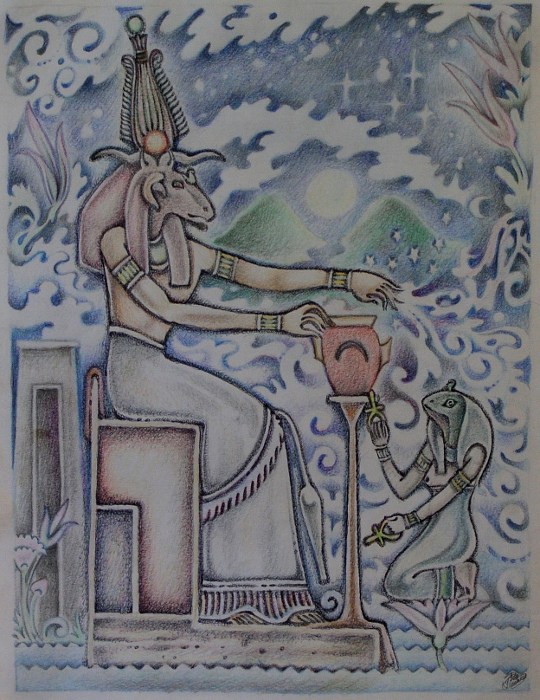RE:
|
HATHOR:Hathor, most commonly known as Het- Hr Het-
Heret, was acclaimed from the earliest to the latest times in Dynastic
History as one of Egypt’s oldest and greatest goddesses. In the capital of Heliopolis, RE syncretized
with the former god of that district to form RE- Atum. One of Hathor’s
names was ‘Hand of Atum’, and in this role, She was that essence of the
god which produced the Universe in an act of cosmic masturbation. She
also was well known as the ‘Eye of RE’, and as such is to be reckoned
one and the same as the goddess, Sekhemet, the female counterpart of the
god, Ptah. |
SEKHEMET:
|
 |
 |
It is also common knowledge
to the student of Egyptian myth that Sekhemet was the consort of Ptah,
as Maat was the consort of Thoth and as Tefnut was the consort of Shu,
so forth and so on. So as these theogonies related to each other in
their uniquely Egyptian way, She could and did assume the personages of
these various goddesses. That She is a manifestation of one from amongst
the eight primordials is indicated when RE seeks the counsel of those
who assisted Him in forming the universe. When Tehuti, in the form of Tekh, created the universe, He was assisted by those who came from the watery mass, the Eye of RE. As wife of Ptah, in the city of the White Wall, Men-Nefer, She was reckoned the mother of Nefertum and also of the deified vizier/architect, Imhotep, to whom was attributed the creation of Zoser’s Step Pyramid. Besides being identified as a goddess of war and pestilence , She was also understood as a goddess of healing in Her more gentle incarnation as Bastet. In very late times, pilgrims visited Her temples and those of Imhotep for their reputation as sanctuaries for the ill. Various titles of the goddess imply that She was of Libyan origin and that at a very early period , She was worshiped by the people of the Northwest Delta. Her iconography suggest strong similarities with other foreign goddesses, some who occasionally were also worshiped in the Delta region. Goddesses such as Astoreth may have shared several distinct qualities with Her rendering them more acceptable to the Egyptian as was probably the case with other deities like Neith and Anat, Set and Baal. |
|
|
BES:Very early on in its history, the
civilization of the Ancient Egyptians had remained remarkably tolerant
of the gods which arrived from cultures beyond its own borders. That the
land of the Nile was of significant geographic importance and location
most likely obliged this phenomenon, as was the case for many of its
neighbors in the Near East. Similarities in function and iconography
would also contribute to such circumstances. |
 |
KHNUM:The cult of the deity, Khnum, apparently one
of the oldest in Egyptian history, was most likely predynastic in orgin.
His manifestation was the flat horned ram, an animal introduced into
Egypt from the 'East' prior to the Archaic period. He was the protector
of King Khufu as the royal titulary signifies, and was the incarnation
of the eight lunar deities of creation. His consort was Heqet, the
amphibian goddess of the Ogdoas. In this aspect he was related with
Djehuti. He was also familiar to Ausaur as a water deity, and as RE
during the Old Kingdom. The Pyramid Texts of King Unas (fifth dynasty)
contain passages that mention Khnum in an archaic character. As 'Creator
of the Egg' he fuses with Qeb and Ptah. Khnum fuses with Sokar in the
fifth division of the Night. He reconstructs the dead near the sanctuary
of Ausaur, the barren place entered through the South Gate guarding the
region of fire, and in this capacity he is the divine reanimator.
|
SATIS (SATET):
|
ANUKIS (ANUKET):
|
AMUN (AMON):As is stated in my vignette of Amunet, Amun was one of Eight primordial deities in the Hermopolitan Ogdoad presided over by a ninth, the lunar god Djehuti. They were the gods that presided in the dark chaos at the beginning of time itself, the germs of all living things. To the ancient Egyptians,this was a great mystery better understood through the heart (or conscience) than with the objective mind. What is most obscure and ironic is that Amun, 'the hidden,' should by the twelfth dynasty, somehow emerge from his own shadowy history and onto the great monuments of the Middle Kingdom. Again in the New Kingdom, he fused with and into the Heliopolan solar deity RE... to form Amun-RE. The once mysterious god so unknowable manifested into the celebrated all prevaiding Creator in the age of Egypt's seventeenth dynasty 'Empire.' |
 |
AMUNET: MUet:Amunet was the feminine principle of the primordial moon god Amun, originally consorting with the other pairs of deities forming the Ogdoad, or dwellers in the city of Eight. They were personifications of Stillness, Silence, Obscurity and Mystery. The name 'Amun,' means 'to be hidden.' During the eleventh and twelfth dynasties, Sehotep-abre-Amenemhat acknowledged the ascendancy of Amun from its shadowy place in Egypt's theogeny by incorporating the name in his royal titulary. By this time Amunet, like her husband and son Amun, had changed according to the roles of a reborn Egypt. She became MeUT-Apet, which illustrates that her lunar influence still predominated her role as 'mother.' She was the original breath of life, and though MeUT signified mother, it was also the common noun for 'vulture.' By the eighteenth dynasty, Amunet had manifested in form to the goddess MeUT, consort of the new kingdom god par excellence Amun Ra. |
NEITH: One of the oldest and
most venerable goddesses of ancient Egypt, Neith, was from the very
earliest times reckoned as the patroness of hunting and warfare par
excellence'. The first known examples of Her iconography appear in
Predynastic period representations which depict the image of a barque
bearing the standard of the 'crossed arrows', the motif later to become
the symbol of Her name. |
By this time, Her
symbol, which was also the standard of Her capital city, was the crossed
arrow and shield and She is depicted wearing the Red Crown of Lower
Egypt. The animals sacred to Her were the Bee and the Elaterid Beetle
(Agrypnus Notodonta). |
***ALL ARTWORK AND LITERATURE COPYWRITED BY CHRISTOPHER TEMARES
THERE SHALL BE NO REPRODUCTION OF ARTWORK AND/OR LITERARY PASSAGES
WITHOUT THE EXPLICIT CONSENT OF THE ARTIST (PAGES 1-6)
PLEASE BE PATIENT WHILE ARTWORK DOWNLOADS (PAGES 1-6)